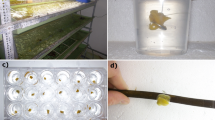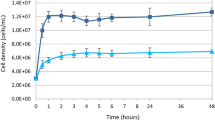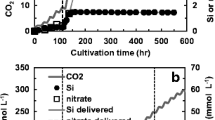Abstract
In vitro culture is one possible method for supplying sponge metabolites for pharmaceutical applications, but appropriate feeding regimens that maximize both growth and metabolite biosynthesis are largely unknown. According to the natural concentration (NC) of cells 1 to 50 µm in size that are available to wild Axinella corrugata, we fed explants a multispecific diet of bacteria, microalgae, and yeast at 4 different concentrations: 1NC, 3NC, 5NC, and 5+1NC (the last consisted of 5 NC of bacteria and 1 NC of microalgae and yeast). Explants fed a 3NC diet had the best culture response, growing on average from 8.5 g to 10.3 g in 8 weeks, and showing a 110% increase in concentration (milligrams per gram of dry weight) of the antitumor compound stevensine. Stevensine production in 3NC explants, representing the total milligrams of metabolite per explant, increased by 157% over the study. Explants fed at 1NC had relatively stable weights, indicating that the diet met metabolic costs only. Explants fed at the two highest concentrations lost weight after 4 weeks, possibly because long-term high cell concentration blocked their aquiferous system, reducing their ability to feed efficiently. Stevensine production in explants fed the 1NC, 5NC, or 5+1NC diets were similar, and varied little from the initial amount. A separate experiment showed that the clearance rate for A. corrugata is similar between the examined food types and cell concentrations over 5 hours, averaging 766 ml h−1 g DW−1.Overall, this study demonstrates that relatively small changes in food abundance can greatly affect both sponge growth and metabolite biosynthesis. The good growth and increased production of the target metabolite stevensine for A. corrugata explants fed a 3NC diet suggests that in vitro culture is a viable method of supplying some sponge metabolites.



Similar content being viewed by others
References
I. Anderson (1999) ArticleTitleOceans plundered in the name of medicine. New Scientist 2002 5
P. Andrade R. Willoughby S.A. Pomponi R.G. Kerr (1999) ArticleTitleBiosynthetic studies of the alkaloid, stevensine, in a cell culture of the marine sponge Teichaxinella morchella. Tetrahedron Lett 40 4775–4778
A.M. Ayling (1981) ArticleTitleThe role of biological disturbance in temperate subtidal encrusting communities. Ecology 62 830–847
A.L. Ayling (1983) ArticleTitleGrowth and regeneration rates in thinly encrusting Demospongiae from temperate waters. Biol Bull 165 343–352
D. Barthel H. Theede (1986) ArticleTitleA new method for the culture of marine sponges and its application for experimental studies. Ophelia 25 75–82
M.A. Becerro M.J. Uriz X. Turon (1997) ArticleTitleChemically-mediated interactions in benthic organisms: the chemical ecology of Crambe crambe (Porifera, Poecilosclerida). Hydrobiologia 356 77–89 Occurrence Handle10.1023/A:1003019221354
M.R. Brown M.A. McCausland K. Kowalski (1998) ArticleTitleThe nutritional value of four Australian microalgal strains fed to Pacific oyster Crassostrea gigas spat. Aquaculture 165 281–293 Occurrence Handle10.1016/S0044-8486(98)00256-7
G. Cronin (2001) Resource allocation in seaweeds and marine invertebrates: chemical defense patterns in relation to defense theories. J.B. McClintock B.J. Baker (Eds) Marine Chemical Ecology. CRC Press Boca Raton, Fla. 325–353
A.R. Duckworth (2001) ArticleTitleFarming sponges for chemicals with pharmaceutical potential. World Aquaculture June 2001 14–18
A.R. Duckworth C.N. Battershill P.R. Bergquist (1997) ArticleTitleInfluence of explant procedures and environmental factors on culture success of three sponges. Aquaculture 165 251–267 Occurrence Handle10.1016/S0044-8486(97)00131-2
J.C. Francis M.A. Poirrier (1986) ArticleTitleParticle uptake in two fresh-water sponge species, Ephydatia fluviatilis and Spongilla alba (Porifera: Spongillidae). Trans Am Microsc Soc 105 11–20
T.M. Frost (1980) ArticleTitleClearance rate determination for the freshwater sponge Spongilla lacustris: effects of temperature, particle type and concentration, and sponge size. Arch Hydrobiol 90 330–356
T. Gerrodette A.O. Flechsig (1979) ArticleTitleSediment-induced reduction in the pumping rate of the tropical sponge Verongia lacunosa. Mar Biol 55 103–110
F.H. Hoff T.W. Snell (1987) Plankton Culture Manual. Florida Aqua Farms Inc. Dade City, Fla.
J. Huysecom E. Richelle-Maurer G. van de Vyver B. Vray (1988) ArticleTitleEffect of bacterial concentration on retention and growth rate of the freshwater sponge Ephydatia fluviatilis. Physiol Zool 61 535–542 Occurrence Handle1:CAS:528:DyaL2sXitFyrs7k%3D
M. Ilan H. Contini S. Carmeli B. Rinkevich (1996) ArticleTitleProgress towards cell cultures from a marine sponge that produces bioactive compounds. J Mar Biotechnol 4 145–149
C.M. Ireland B.R. Copp M.P. Foster L.A. McDonald D.C. Radisky J.C. Swersey (1993) Biomedical potential of marine natural products. D.H. Attaway O.R. Zaborsky (Eds) Marine Biotechnology, Volume 1: Pharmaceutical and Bioactive Natural Products. Plenum Press New York, N.Y. 1–43
M.H. Kreuter A.R. Robitzki S. Chang R. Steffen M. Michaelis Z. Kljajic M. Bachmann H.C. Schröder W.E.G. Müller (1992) ArticleTitleProduction of the cytostatic agent aeroplysinin by the sponge Verongia aerophoba in in vitro culture. Comp Biochem Physiol 101 183–187 Occurrence Handle10.1016/0742-8413(92)90217-U Occurrence Handle1:STN:280:By2B1cbit1A%3D
J.P. Mercer K.S. Mai J. Donlon (1993) ArticleTitleComparative studies on the nutrition of two species of abalone, Haliotis tuberculata Linnaeus and Haliotis discus hannai Ino 1: effects of alga diets on growth and biochemical composition. Invert Reprod Dev 23 75–88 Occurrence Handle1:CAS:528:DyaK2cXhs1anurw%3D
R.W. Newbold P.R. Jensen W. Fenical J.R. Pawlik (1999) ArticleTitleAntimicrobial activity of Caribbean sponge extracts. Aquatic Micro Ecol 19 279–284
M. Nickel S. Leininger G. Proll F. Brümmer (2001) ArticleTitleComparative studies on two potential methods for the biotechnological production of sponge biomass. J Biotechnol 92 169–178 Occurrence Handle10.1016/S0168-1656(01)00357-1 Occurrence Handle1:CAS:528:DC%2BD3MXnsF2hs7Y%3D Occurrence Handle11640986
R. Osinga E. Planas Muela J. Tramper R.H. Wijffels (1997) In vitro cultivation of four marine sponge species: determination of the nutritional demands. Y. Le Gal A. Muller-Feuga (Eds) Marine Microorganisms for Industry. Issy-les-Moulineaux France: Ifremer 121–127
R. Osinga P.B. de Beukelaer E.M. Meijer J. Tramper R.H. Wijffels (1999a) ArticleTitleGrowth of the sponge Pseudosuberites (aff.) andrewsi in a closed system. J Biotechnol 70 155–161 Occurrence Handle1:CAS:528:DyaK1MXjs1Shs7Y%3D
R. Osinga J. Tramper R.H. Wijffels (1999b) ArticleTitleCultivation of marine sponges. Mar Biotechnol 1 509–532 Occurrence Handle1:CAS:528:DC%2BD3cXktFCjuw%3D%3D
R. Osinga R. Kleijn E. Groenendijk . Niesink J. Tramper R.H. Wijffels (2001) ArticleTitleDevelopment of in vivo sponge cultures: particle feeding by the tropical sponge Pseudosuberites aff. andrewsi. Mar Biotechnol 3 544–554 Occurrence Handle10.1007/s1012601-0078-2 Occurrence Handle1:CAS:528:DC%2BD38XotVWhtw%3D%3D
A.J. Pile (1999) ArticleTitleResource partitioning by Caribbean coral reef sponges: is there enough food for everyone? Memoirs Queensland Museum 44 457–461
A.J. Pile M.R. Patterson J.D. Witman (1996) ArticleTitle In situ grazing on plankton >10µm by the boreal sponge Mycale lingua. Mar Ecol Prog Ser 141 95–102
M.A. Poirrier J.C. Francis R.A. LaBiche (1981) ArticleTitleA continuous-flow system for growing fresh-water sponges in the laboratory. Hydrobiologia 79 255–259
S.A. Pomponi R. Willoughby M.E. Kaighn A.E. Wright (1997) Development of techniques for in vitro production of bioactive natural products from marine sponges. K. Maramorosch J. Mitsuhashi (Eds) Invertebrate Cell Culture: Novel Directions and Biotechnology Applications. Science Publishers Enfield, N.H. 231–237
H.M. Reiswig (1971) ArticleTitleParticle feeding in natural populations of three marine demosponges. Biol Bull 141 568–591
H.M. Reiswig (1974) ArticleTitleWater transport, respiration and energetics of three tropical marine sponges. J Exp Mar Biol Ecol 14 231–249 Occurrence Handle10.1016/0022-0981(74)90005-7
M. Ribes R. Coma J.M. Gili (1999) ArticleTitleNatural diet and grazing rate of the temperate sponge Dysidea avara (Demospongiae, Dendroceratida) throughout an annual cycle. Mar Ecol Prog Ser 176 179–190
H.U. Riisgård S. Thomassen H. Jakobsen J.M. Weeks P.S. Larsen (1993) ArticleTitleSuspension feeding in marine sponges Halichondria panicea and Haliclona urceolus: effects of temperature on filtration rate and energy cost of pumping. Mar Ecol Prog Ser 96 177–188
F.J. Schmitz B.F. Bowden S.I. Toth (1993) Antitumor and cytotoxic compounds from marine organisms. D.H. Attaway O.R. Zaborsky (Eds) Marine Biotechnology, Volume 1: Pharmaceutical and Bioactive Natural Products. Plenum Press New York, N.Y. 197–308
J.E. Thompson P.T. Murphy P.R. Bergquist E.A. Evans (1987) ArticleTitleEnvironmentally induced variation in diterpene composition of the marine sponge Rhopaloeides odorabile. Biochem Syst Ecol 15 595–606 Occurrence Handle1:CAS:528:DyaL2sXmtlenurY%3D
X. Turon M.A. Becerro M.J. Uriz (1996) ArticleTitleSeasonal patterns of toxicity in benthic invertebrates: the encrusting sponge Crambe crambe (Poeciloslerida). Oikos 75 33–40
D.M. Wilson M. Puyana W. Fenical J.R. Pawlik (1999) ArticleTitleChemical defense of the Caribbean Reef sponge Axinella corrugata against predatory fishes. J Chem Ecol 25 2811–2823 Occurrence Handle10.1023/A:1020811810223 Occurrence Handle1:CAS:528:DyaK1MXnvFyitro%3D
A.E. Wright S.A. Chiles S.S. Cross (1991) ArticleTitle3-Amino-1-(2-aminoimidazoyl)-prop-1-ene from the marine sponges Teichaxinella morchella and Ptilocaulis walpersi. J Nat Prod 54 1684–1686 Occurrence Handle1:CAS:528:DyaK38XisFant7Y%3D
Acknowledgements
We thank Dr. Peter McCarthy and the HBOI fermentation group for media supplies, and Deborah Pierce and the two anonymous referees for helpful comments on the manuscript. The research was funded through a postdoctoral fellowship from the Harbor Branch Institution and the Gertrude E. Skelly Charitable Foundation. The experiments performed in this study comply with the current laws of the United States. This is HBOI contribution number 1503.
Author information
Authors and Affiliations
Corresponding author
Rights and permissions
About this article
Cite this article
Duckworth, A.R., Samples, G.A., Wright, A.E. et al. In Vitro CuIture of the Tropical Sponge Axinella corrugata (Demospongiae): Effect of Food Cell Concentration on Growth, Clearance Rate, and Biosynthesis of Stevensine . Mar. Biotechnol. 5, 519–527 (2003). https://doi.org/10.1007/s10126-002-0111-0
Received:
Accepted:
Published:
Issue Date:
DOI: https://doi.org/10.1007/s10126-002-0111-0




